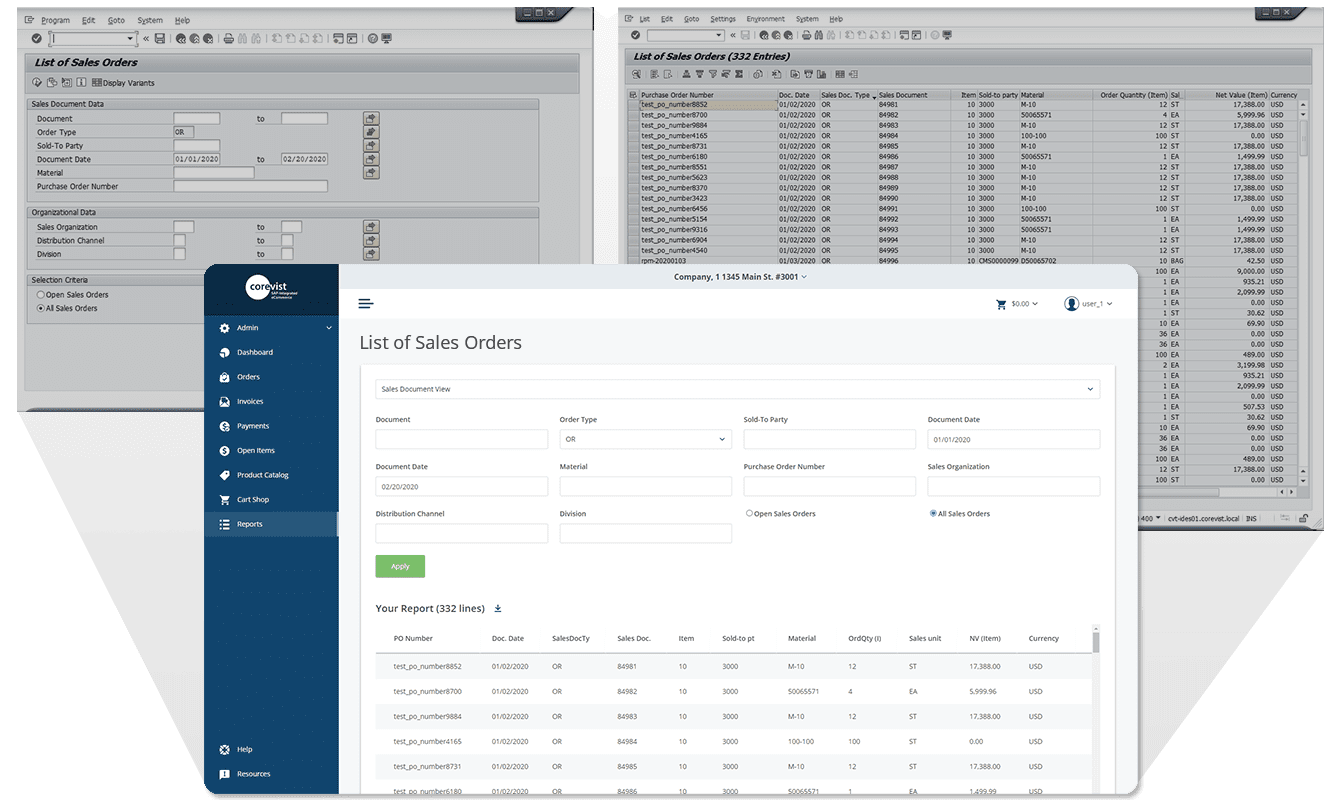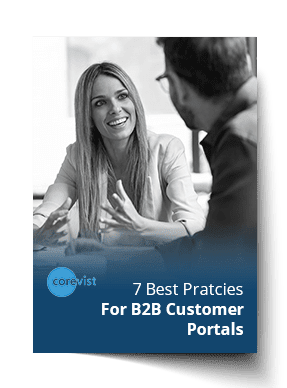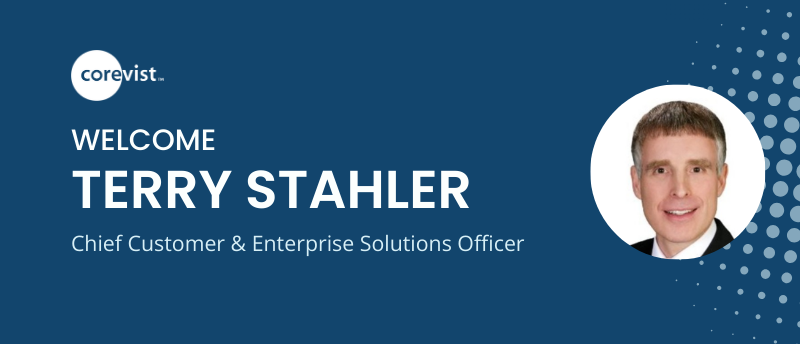Share
Author
George Anderson
Share
First published Jul 1, 2021. Updated Apr 6, 2022.
Manufacturers are scrambling to launch SAP customer portal solutions in the post-COVID world. The pandemic made the need for self-service painfully clear—but it also exposed a preference that B2B buyers already had: They wanted direct, digital purchasing that’s as easy as Amazon long before COVID made it essential.
Yet manufacturers struggle with customer portals. Conventional B2B eCommerce platforms offer some of the required functionality, but they can’t provide real-time SAP ERP integration. That integration lies at the heart of the functionality that customers need most in a portal.
What’s more, conventional B2B eCommerce solutions often come bundled with a product catalog. For manufacturers who aren’t ready to transition to online ordering (but who need to offer self-service for post-order care), these solutions aren’t a great fit.
So what should manufacturers look for in a customer portal solution?
Here are the three essentials (click to jump).
1. A user experience that’s actually built for manufacturers’ customers
2. Technology that can deliver essential B2B personalization
3. A project methodology that puts customer value first
1. A user experience that’s actually built for manufacturers’ customers
A manufacturer’s customer portal is a unique solution. While it may have an eCommerce component, it doesn’t have much in common with B2C eCommerce (where look and feel, branding and merchandising capabilities are often most important).
Manufacturers’ customers have needs that B2C consumers never experience. That’s why manufacturing customer portals must support the full complexity of doing business with the organization.
Here’s what that means in terms of features and user experience.
Real-time order status, shipment status and order history
At the very least, a manufacturing customer portal must offer self-service capabilities for post-order care. It needs to provide fast, easy answers for the most basic account management questions.
- Where’s my order? Did it ship?
- Should I expect a partial shipment, or am I getting everything at once?
- What did we order last month? I lost my paperwork and I need a new copy.
- I’m getting worried. Did I assign my last order to the proper sold-to?
- A shipment came, but not everything is here, and the paperwork says some SKUs are on backorder. What’s the status with those line items today?
A proper customer portal should be able to answer these questions. Here’s what that looks like in Corevist Commerce Cloud.
Note: This data is only available in the customer portal through real-time SAP integration. Without that integration, you’ll have to rely on batch updates between the portal and SAP — which means the information can get outdated fast. This is why Corevist Commerce Cloud is architected with real-time SAP integration built in.
Ability to build and place orders online (with all personalized business rules enforced)
Manufacturers’ transactions are unique. With customer-specific business rules governing things like pricing, inventory availability and SKU permissions, there’s no such thing as a generic transaction.
Most manufacturers have invested heavily to build out that data and logic in SAP. This is what makes it hard to imagine transitioning order placement to a customer portal. What eCommerce solution could possibly support that complexity?
FREE whitepaper
7 Best Practices For B2B Customer Portals
Start with a goal of reducing phone, fax, and email inquiries—and put the voice of the customer first. But don’t create more work for IT.
ERP-centric organizations should look for solutions that automatically honor their ERP data and logic. This is especially true when it comes to online ordering. If a portal solution introduces order errors or requires manual callbacks from customer service, then it isn’t doing its job.
The key to error-free order placement is direct, real-time SAP integration that conforms every order to the appropriate business rules in SAP. (Hint: Corevist’s comprehensive, real-time SAP integration includes 49 major integration points and 420+ ABAP objects. We automatically bring your unique ordering rules to the web.)
Real-time credit status
For some manufacturers’ customers, this feature is essential to self-service ordering within the portal. If a customer’s credit status will prevent their order from being fulfilled, the customer needs visibility into that fact within the portal. Ideally, you would also empower them to pay down invoices through self-service to stay off credit block. (More on payments below.)
Like every other essential feature, this one requires real-time SAP integration.
Real-time price and availability
If manufacturers’ customers are going to use the portal, they need self-service access to information that they would normally get from customer service.
When it comes to planning orders, customers need to know the price and availability for any SKU that they’re allowed to buy.
While not all manufacturers choose to include online ordering capabilities in their portal, they still need to show contract pricing and availability in real time (with support for any customer-level personalization of that data).
Unfortunately, it’s difficult to present real-time pricing and availability if your portal solution isn’t built on SAP integration. This is why Corevist Commerce Cloud includes deep, prebuilt integration to SAP ERP (more on that below).
Self-service invoice history, status and payments
Your portal won’t be a true self-service destination if customers can’t manage their invoices in it. To give them full control of their account standing, your portal should give customers the ability to see their entire invoice history, open items, and invoice status. Ideally, you would also give them the ability to pay down invoices within the portal.
Dynamic web reports pulled from SAP
Some manufacturers have complex processes for interacting with customers. If those processes are built out in SAP logic, the customer portal should support that SAP logic with a minimum of custom development work.
For many manufacturers, the best solution is to display dynamic SAP reports on the web (as Corevist Commerce Cloud does).

In Corevist Commerce Cloud, the reports that you choose to enable are automatically accessible to any customer who has the appropriate permissions.
Read more here: Corevist’s dynamic SAP web reports.
2. Technology that can deliver essential B2B personalization
Here’s the problem for manufacturing customer portals: Personalization is essential to a true B2B user experience. And accurate personalization depends on SAP data and business rules.
Clearly, some form of SAP ERP integration is essential to deliver that personalization in a customer portal. There are really only two options for architecture here.
A. Customer portal with batch-based integration using middleware
In this architecture, a middleware solution sits between the manufacturer’s customer portal and their SAP system. Periodic batch updates are required to refresh the customer portal with accurate SAP data (and to post orders from the portal to the SAP, if online ordering is enabled).
Batch synchronization works fine for datapoints with low refresh rates — for example, SKU permissions, related products, or product documentation.
However, batch synchronization won’t give customers the real-time data and capabilities they need for the buying cycle. A customer portal without real-time integration can’t display crucial information like accurate inventory quantities, order status, shipment tracking, or credit status.
(Hint: Our client Emmerson Packaging came to us with this exact problem. Check out their story here.)
Middleware isn’t only bad for customer experience. It’s often far too difficult for manufacturers to maintain, as it requires three duplicate systems (SAP ERP, middleware, and the customer portal) that need their own maintenance of data and business logic. Many manufacturers end up with three separate teams managing these three systems. Ultimately, that high cost and complexity can threaten the viability of the customer portal.
For these reasons, batch-based architecture is typically a mistake for manufacturers who just need a portal for online interaction with customers.
Luckily, there is an alternative.
Want to become Easier To Do Business With?
Check out Corevist Commerce Cloud.
Managed B2B portals and eCommerce with prebuilt integration for ECC and S/4HANA.
B. Customer portal with direct, real-time SAP integration built in
For many manufacturers, every customer interaction is 100% dependent on SAP logic and data.
In these cases, there’s really just one viable approach to customer portals. The solution should be built on a direct, real-time SAP integration. This is the only way to get 100% accurate personalization in the portal for every customer, as it provides everything the user needs to do business with you online.
- Real-time inventory availability (including personalized ATP, if applicable)
- Real-time contract pricing (including bundled pricing and scaled pricing discounts)
- Real-time credit status (so the customer can tell if their order will go on credit block)
- Real-time invoice payments (so the customer can bring down their credit balance if necessary before placing a new order)
- Real-time, 100% error-free order posting to SAP (with intelligent error messaging to the user to help them fix order problems)
- Real-time order status and tracking, plus shipment tracking (so customers can actually manage their accounts in the portal rather than calling customer service)
This is just a small sample of the functionality that manufacturers can only get in a real-time portal.
3. A project methodology that puts customer value first
Customer portal projects fail when manufacturers don’t include the voice of their customers from the start.
Even the most customer-centric organizations can struggle here. Many manufacturers launch customer portals because they know they need to change. The rising tide of digital expectations is putting pressure on them to evolve. Many organizations dive headlong into the project and hope that real transformation and better customer engagement will just happen.
Unfortunately, optimism alone won’t make a successful customer portal project.
For manufacturers launching portal solutions, it’s essential to bake in the voice of the customer from the very beginning. That means your rollout methodology must include two crucial features.
1. A concrete plan for showing the unfinished portal to real customers and gathering their feedback.
2. An organizational willingness to act on that feedback — and the experience to know which changes matter for the launch, and which changes can wait for a later iteration.
Most manufacturers can handle #1 on their own. It’s simple project management.
However, manufacturers who have no experience with customer portals may not be equipped to handle #2. Without experience in numerous customer portal rollouts, manufacturers may not be able to act as referees in sorting out competing interests in the project.
This is where a managed solution partner like Corevist brings value beyond just the technology. We’ve launched so many Corevist portals for manufacturers, we’ve developed a lean, Agile methodology for prioritizing customer feedback and delivering maximum value at launch.
Of course, GoLive day is just the beginning. Many vendors say goodbye after that day, turning over responsibility for the portal to the client.
Corevist takes a different approach. We stick around for the life of your customer portal. We not only manage and support our technology — we also advise on your growth goals and help you build ongoing plans to maximize the value of your portal.
Want to become Easier To Do Business With?
Check out Corevist Commerce Cloud.
Managed B2B portals and eCommerce with prebuilt integration for ECC and S/4HANA.










